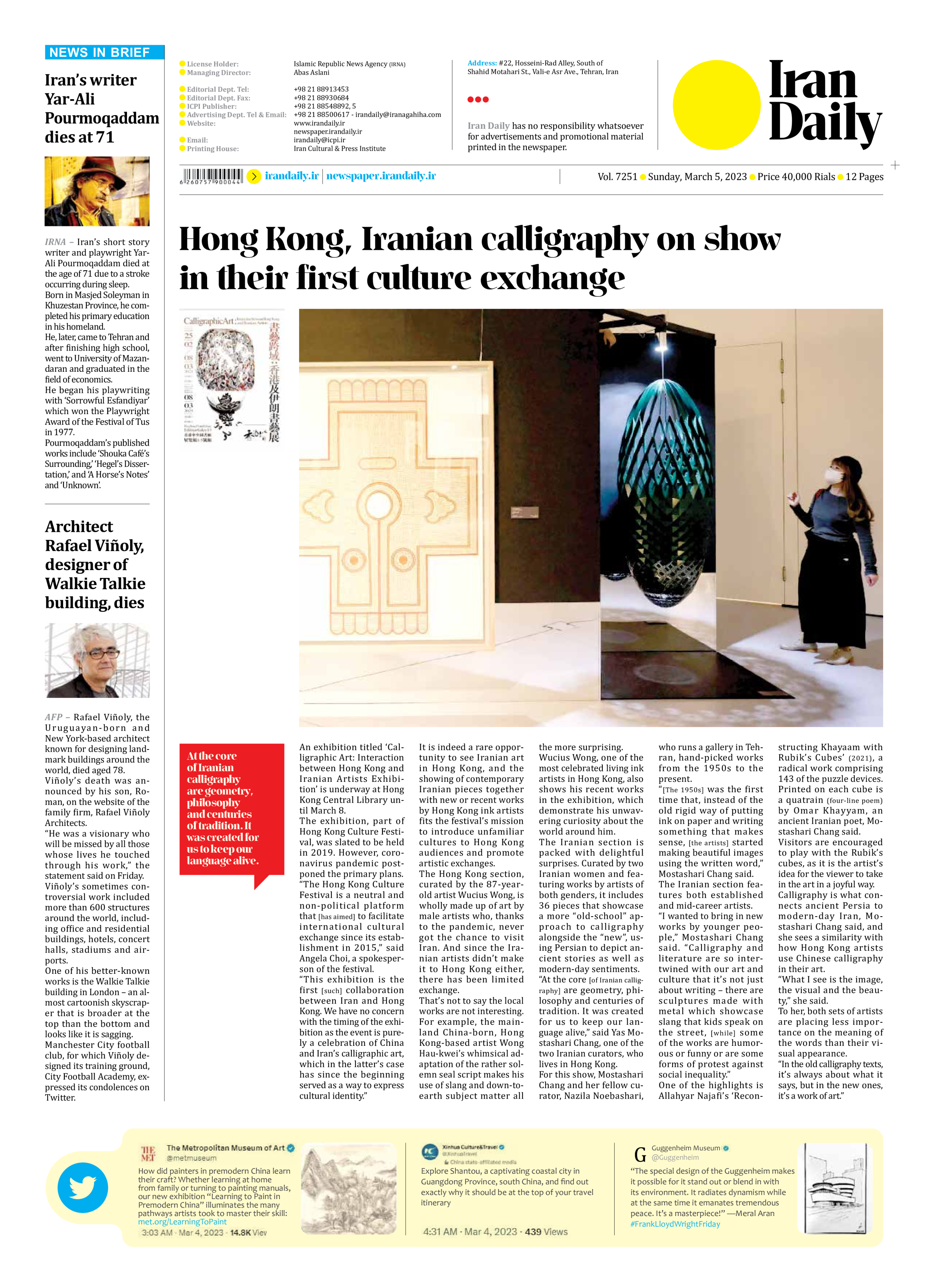
Hong Kong, Iranian calligraphy on show in their first culture exchange
An exhibition titled ‘Calligraphic Art: Interaction between Hong Kong and Iranian Artists Exhibition’ is underway at Hong Kong Central Library until March 8.
The exhibition, part of Hong Kong Culture Festival, was slated to be held in 2019. However, coronavirus pandemic postponed the primary plans.
“The Hong Kong Culture Festival is a neutral and non-political platform that [has aimed] to facilitate international cultural exchange since its establishment in 2015,” said Angela Choi, a spokesperson of the festival.
“This exhibition is the first [such] collaboration between Iran and Hong Kong. We have no concern with the timing of the exhibition as the event is purely a celebration of China and Iran’s calligraphic art, which in the latter’s case has since the beginning served as a way to express cultural identity.”
It is indeed a rare opportunity to see Iranian art in Hong Kong, and the showing of contemporary Iranian pieces together with new or recent works by Hong Kong ink artists fits the festival’s mission to introduce unfamiliar cultures to Hong Kong audiences and promote artistic exchanges.
The Hong Kong section, curated by the 87-year-old artist Wucius Wong, is wholly made up of art by male artists who, thanks to the pandemic, never got the chance to visit Iran. And since the Iranian artists didn’t make it to Hong Kong either, there has been limited exchange.
That’s not to say the local works are not interesting.
For example, the mainland China-born, Hong Kong-based artist Wong Hau-kwei’s whimsical adaptation of the rather solemn seal script makes his use of slang and down-to-earth subject matter all the more surprising.
Wucius Wong, one of the most celebrated living ink artists in Hong Kong, also shows his recent works in the exhibition, which demonstrate his unwavering curiosity about the world around him.
The Iranian section is packed with delightful surprises. Curated by two Iranian women and featuring works by artists of both genders, it includes 36 pieces that showcase a more “old-school” approach to calligraphy alongside the “new”, using Persian to depict ancient stories as well as modern-day sentiments.
“At the core [of Iranian calligraphy] are geometry, philosophy and centuries of tradition. It was created for us to keep our language alive,” said Yas Mostashari Chang, one of the two Iranian curators, who lives in Hong Kong.
For this show, Mostashari Chang and her fellow curator, Nazila Noebashari, who runs a gallery in Tehran, hand-picked works from the 1950s to the present.
“[The 1950s] was the first time that, instead of the old rigid way of putting ink on paper and writing something that makes sense, [the artists] started making beautiful images using the written word,” Mostashari Chang said.
The Iranian section features both established and mid-career artists.
“I wanted to bring in new works by younger people,” Mostashari Chang said. “Calligraphy and literature are so intertwined with our art and culture that it’s not just about writing – there are sculptures made with metal which showcase slang that kids speak on the street, [while] some of the works are humorous or funny or are some forms of protest against social inequality.”
One of the highlights is Allahyar Najafi’s ‘Reconstructing Khayaam with Rubik’s Cubes’ (2021), a radical work comprising 143 of the puzzle devices.
Printed on each cube is a quatrain (four-line poem) by Omar Khayyam, an ancient Iranian poet, Mostashari Chang said.
Visitors are encouraged to play with the Rubik’s cubes, as it is the artist’s idea for the viewer to take in the art in a joyful way.
Calligraphy is what connects ancient Persia to modern-day Iran, Mostashari Chang said, and she sees a similarity with how Hong Kong artists use Chinese calligraphy in their art.
“What I see is the image, the visual and the beauty,” she said.
To her, both sets of artists are placing less importance on the meaning of the words than their visual appearance.
“In the old calligraphy texts, it’s always about what it says, but in the new ones, it’s a work of art.”







